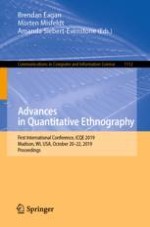2019 | Buch
Advances in Quantitative Ethnography
First International Conference, ICQE 2019, Madison, WI, USA, October 20–22, 2019, Proceedings
herausgegeben von: Brendan Eagan, Morten Misfeldt, Amanda Siebert-Evenstone
Verlag: Springer International Publishing
Buchreihe : Communications in Computer and Information Science
